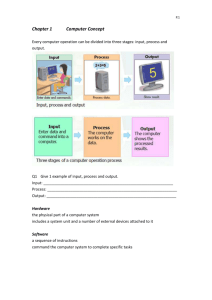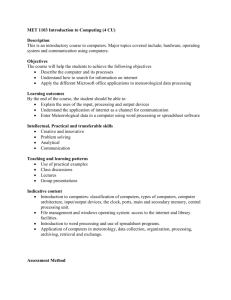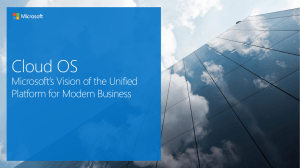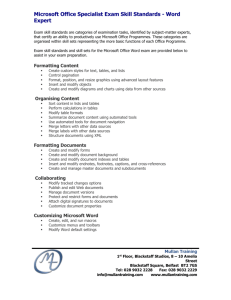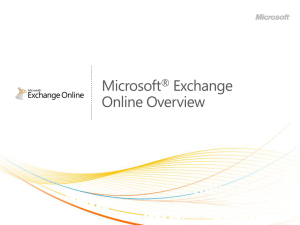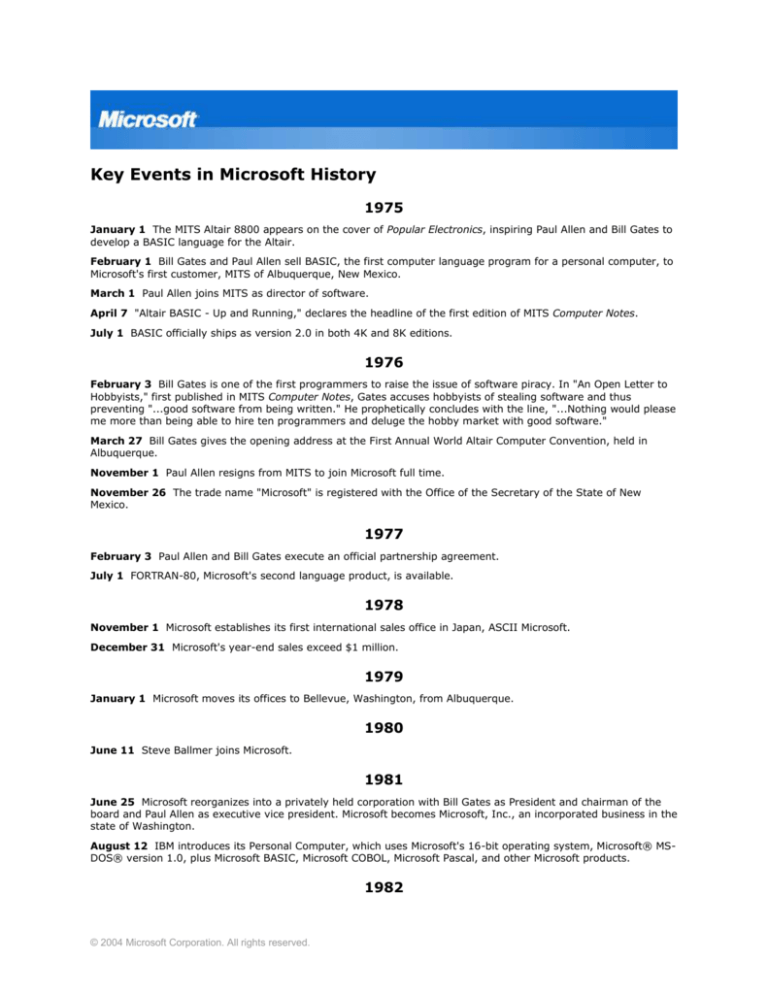
Key Events in Microsoft History
1975
January 1 The MITS Altair 8800 appears on the cover of Popular Electronics, inspiring Paul Allen and Bill Gates to
develop a BASIC language for the Altair.
February 1 Bill Gates and Paul Allen sell BASIC, the first computer language program for a personal computer, to
Microsoft's first customer, MITS of Albuquerque, New Mexico.
March 1 Paul Allen joins MITS as director of software.
April 7 "Altair BASIC - Up and Running," declares the headline of the first edition of MITS Computer Notes.
July 1 BASIC officially ships as version 2.0 in both 4K and 8K editions.
1976
February 3 Bill Gates is one of the first programmers to raise the issue of software piracy. In "An Open Letter to
Hobbyists," first published in MITS Computer Notes, Gates accuses hobbyists of stealing software and thus
preventing "...good software from being written." He prophetically concludes with the line, "...Nothing would please
me more than being able to hire ten programmers and deluge the hobby market with good software."
March 27 Bill Gates gives the opening address at the First Annual World Altair Computer Convention, held in
Albuquerque.
November 1 Paul Allen resigns from MITS to join Microsoft full time.
November 26 The trade name "Microsoft" is registered with the Office of the Secretary of the State of New
Mexico.
1977
February 3 Paul Allen and Bill Gates execute an official partnership agreement.
July 1 FORTRAN-80, Microsoft's second language product, is available.
1978
November 1 Microsoft establishes its first international sales office in Japan, ASCII Microsoft.
December 31 Microsoft's year-end sales exceed $1 million.
1979
January 1 Microsoft moves its offices to Bellevue, Washington, from Albuquerque.
1980
June 11 Steve Ballmer joins Microsoft.
1981
June 25 Microsoft reorganizes into a privately held corporation with Bill Gates as President and chairman of the
board and Paul Allen as executive vice president. Microsoft becomes Microsoft, Inc., an incorporated business in the
state of Washington.
August 12 IBM introduces its Personal Computer, which uses Microsoft's 16-bit operating system, Microsoft® MSDOS® version 1.0, plus Microsoft BASIC, Microsoft COBOL, Microsoft Pascal, and other Microsoft products.
1982
© 2004 Microsoft Corporation. All rights reserved.
March 24 Microsoft U.K. Ltd. (United Kingdom) is incorporated.
June 28 Microsoft announces a new corporate logo, new packaging, and a comprehensive set of retail dealer
support materials.
1983
February 18 Paul Allen resigns as Microsoft's executive vice president, but remains on the Board of Directors.
May 2 Microsoft introduces the Microsoft Mouse.
September 29 Microsoft introduces Word for MS-DOS 1.00.
November 10 Microsoft unveils Microsoft Windows®, an extension of the MS-DOS operating system that provides
a graphical operating environment. The first retail version of Windows would not ship until November 1985.
1984
January 24 Microsoft ships BASIC and Multiplan simultaneously with the introduction of the Macintosh, becoming
a leader in developing software for Apple computers.
July 11 Microsoft Press introduces its first two titles: Cary Lu's The Apple Macintosh Book and Peter Norton's
Exploring the IBM PCjr Home Computer.
1985
August 12 Microsoft celebrates its 10th anniversary with FY85 sales figures of $140 million.
September 3 Microsoft selects the Republic of Ireland as the site of its first production facility outside of the U.S.
to produce software products to be sold in the European market.
November 20 Microsoft ships the retail version of Microsoft Windows.
1986
February 26 Microsoft moves to a new corporate campus in Redmond, WA.
March 13 Microsoft stock goes public at $21 per share, rising to $28 per share by the end of the first trading day
and raising $61 million.
1987
April 2 Microsoft and IBM announce OS/2. This is the first product to be announced as a result of the Joint
Development Agreement between Microsoft and IBM in August 1985.
September 8 Microsoft ships its first CD-ROM application, Microsoft Bookshelf, a collection of 10 of the most
popular and useful reference works on a single CD-ROM disk.
1988
January 13 Microsoft and Ashton-Tate announce Microsoft SQL Server™, a relational database server software
product for Local Area Networks (LANs) based on a relational database management system licensed from Sybase.
1988
August 1 Microsoft announces Office, the first general business software for Macintosh systems available on CDROM.
November 13 Microsoft and IBM broaden the scope of their development agreement by agreeing to jointly
develop a consistent, full range of systems software offerings for the 1990s. These software offerings will include
enhancements to MS-DOS, Microsoft OS/2, and Microsoft LAN products and are compatible with the Intel 386 and
486 microprocessors.
December 27 Microsoft announces that Jon Shirley will retire as president and chief operating officer on June 30,
1990. Shirley, who has been president since August of 1983, will continue to play a role in the management of the
company as a member of the Board of Directors and as a consultant for strategic projects.
1990
© 2004 Microsoft Corporation. All rights reserved.
April 2 Microsoft appoints Michael R. Hallman as president and chief operating officer, to succeed upon Jon
Shirley's retirement.
July 25 Kicking off its 15th-anniversary celebration, Microsoft becomes the first personal computer software
company to exceed $1 billion in sales in a single year, with revenues of $1.18 billion.
November 12 Bill Gates unveils his vision of the future of computing in his keynote address, "Information at Your
Fingertips," at Fall/COMDEX '90.
1991
January 1 Microsoft Corp. becomes one of the first software companies to create its own computer-science
research organization, Microsoft Research (later MSR).
May 20 Microsoft announces Microsoft Visual BASIC for Windows at Windows World '91 in Atlanta.
November 14 Microsoft announces the Multimedia Edition of Works for Windows 2.0, Microsoft's first business
application to incorporate multimedia.
1992
March 1 Microsoft kicks off its first television advertising campaign. The TV ads are designed to build on the
success of Windows and Windows-based applications.
March 1 A three-person Office of the President is created, with three centers of strategic focus: Worldwide
Product Group, headed by Mike Maples; Worldwide Sales and Support Group, headed by Steve Ballmer; and
Worldwide Operations Group, headed by Frank Gaudette.
April 6 Microsoft ships Microsoft Windows 3.1 with more than 1,000 enhancements. The new version creates
unprecedented user demand, with more than 1 million advance orders placed worldwide.
April 27 The Microsoft Board of Directors approves a 3-for-2 stock split.
June 23 Bill Gates accepts the National Medal of Technology for Technological Achievement from President Bush.
1993
January 1 Microsoft announces the 10th anniversary of Microsoft Word, which first shipped for MS-DOS in 1983,
on the Macintosh platform in 1984, and on the Windows platform in 1989. Based on data released by Dataquest,
Inc. there are more than 10 million Word users worldwide.
March 22 Microsoft Encarta, the first multimedia encyclopedia designed for a computer, is available.
April 14 Microsoft reports that the number of licensed users of Microsoft Windows now totals more than 25
million, making it the most popular graphical operating system in the world.
May 24 Microsoft launches Windows NT at Windows World in Atlanta.
December 6 Microsoft is named the "1993 Most Innovative Company Operating in the U.S." by Fortune magazine
as part of its Fifth Annual Study of America's Best Cities for Business.
1994
April 18 Microsoft Windows for Workgroups 3.11 has become the world's best-selling retail operating system,
edging Windows 3.1 into the No. 2 spot.
June 28 Microsoft acquires SoftImage, the leading developer of high-performance 2-D and 3-D computer
animation and visualization software.
September 8 Microsoft announces that Windows 95 is the official name for the next version of Windows,
codenamed "Chicago."
November 8 Bob Herbold joins Microsoft as the new executive vice president and the chief operating officer.
November 14 Microsoft debuts its new international advertising campaign, "Where Do You Want To Go Today," at
actor Robert DeNiro's trendy SoHo restaurant in New York.
© 2004 Microsoft Corporation. All rights reserved.
1995
March 22 Microsoft and DreamWorks SKG announce that they have signed a joint-venture agreement to form a
new software company designed to produce interactive and multimedia entertainment properties.
August 24 Microsoft Windows 95 is available worldwide.
November 20 MSN™, The Microsoft Network online service, enrolls more than 525,000 members in its first three
months of service, making MSN one of the largest Internet service providers.
November 20 Bill Gates authors his first book; The Road Ahead looks at how new technologies will guide the way
we work, play, and live in the future.
1996
January 16 Microsoft acquires Vermeer Technologies and its flagship software application, FrontPage.
February 6 Microsoft names Mattel USA President and Chief Operating Officer Jill E. Barad to its Board of
Directors. Barad is the first woman named to the Microsoft Board of Directors since Portia Isaacson served in 1986
and 1987.
June 5 MSNBC, the 24-hour news, talk, and information network from NBC News and Microsoft, debuts.
June 24 Slate™, an interactive magazine of politics, culture, and public policy edited by Michael Kinsley, goes live
on the Internet.
November 7 Microsoft Flight Simulator for Windows 95 releases, marking the first time in its 14-year history that
the product is available on the Windows platform.
November 12 Microsoft's Board of Directors approves a 2-for-1 stock split.
December 3 The Executive Committee replaces the Office of the President as the most senior management team
at the company.
1997
April 6 Microsoft acquires WebTV Networks for approximately $425 million in stock and cash.
June 23 Microsoft founder Bill Gates and his wife, Melinda French Gates, announce the formation of the Gates
Library Foundation.
October 21 The Justice Department files a motion in Federal District Court, alleging that Microsoft violated a 1994
consent decree dealing with certain aspects of licensing the Windows operating system to computer manufacturers.
Specifically, the Justice Department asks the court to stop Microsoft from tying the use of its Windows 95 operating
system to the use of its Internet browser, a tool to navigate the Internet.
November 25 Pollsters Hart and Teeter find that Microsoft is the most admired company in one of the most
admired industries in America. When the public is asked to volunteer, without being prompted, the names of one or
two companies they respect and admire, Microsoft is named by 25 percent. IBM and General Motors are next, at 16
percent, followed by AT&T and Wal-Mart at 15 percent.
1998
January 26 Microsoft Corporation's Board of Directors approves a 2-for-1 split of its common shares. This is the
seventh time the common stock has split since the company went public on March 13, 1986.
June 25 Windows 98 is available in more than 40 countries worldwide and from more than 12,000 retail outlets in
North America.
July 21 Bill Gates appoints Steve Ballmer president of Microsoft.
October 16 The antitrust trial against Microsoft begins in Washington D.C.
November 16 Microsoft SQL Server version 7.0 is launched at COMDEX and receives PC Week's "Best of Show"
and "Best Productivity Software" awards.
1999
January 8 Microsoft launches Encarta Africana, the first comprehensive encyclopedia of black history and culture.
February 24 Microsoft opens its first online store, Shop.
© 2004 Microsoft Corporation. All rights reserved.
March 18 Bill Gates introduces Internet Explorer 5.0 at a launch event on the Microsoft campus in Redmond. By
the following week, more than 1 million downloads of the new version have taken place.
March 24 Bill Gates releases his latest book, Business @ the Speed of Thought, published by Warner Books. At
the heart of the new book is a single idea: For businesses to think and move quickly enough to succeed in the fastpaced digital economy, they must enable the flow of digital information.
June 7 Steve Ballmer officially launches Microsoft Office 2000, a key element of the company's vision of
"Knowledge Workers Without Limits."
September 13 Microsoft announces Windows Distributed interNet Architecture (Windows DNA) 2000, a
comprehensive, integrated platform for building and operating state-of-the-art distributed Web applications as well
as the next wave of Internet-based Web services.
2000
January 7 Microsoft acquires Visio Corporation, the largest acquisition in Microsoft's history.
January 13 Bill Gates creates a new role for himself -- chairman and chief software architect -- so that he can
dedicate all of his time to helping drive the next generation Windows Internet platform and services. Steve Ballmer
becomes president and CEO, and will take over management of the company.
April 3 Microsoft announces the retail availability of Microsoft Project 2000 and the companion, Web-based
Microsoft Project Central, a major upgrade to the world's best-selling project-management software, with more
than 5 million users.
June 22 Microsoft unveils the Microsoft® .NET platform, the vision and road map for its next generation of
software and services. Microsoft .NET (pronounced "dot-net") will provide easier, more personalized, and more
productive Internet experiences by harnessing constellations of smart devices and Web sites with advanced
software through Internet protocols and formats.
September 14 Microsoft announces the availability of Microsoft® Windows® Millennium Edition (Windows Me).
September 20 Warner Books publishes Inside Out, Microsof—In Our Own Words, a commemorative 25th
anniversary book.
2001
February 13 Microsoft Windows XP operating system makes its public debut at the Experience Music Project in
Seattle.
May 31 Microsoft Office XP launches, promising to unlock hidden knowledge and unleash the next wave of
productivity gains.
October 25 Microsoft Windows XP is released worldwide.
November 15 Microsoft Xbox® launches, offering the only system on the market designed from the ground up to
deliver a complete online gaming experience.
2002
January 15 Bill Gates issues a companywide memo emphasizing that Microsoft's must lead the industry to a new
level of Trustworthiness in computing.
February 13 Microsoft Visual Studio® .NET launches during the VSLive! Conference in San Francisco.
March 18 Microsoft and those states not agreeing to the settlement reached by the U.S. Department of Justice,
began a trial on remedies in the U.S. District Court in Washington, D.C.
April 4 Microsoft President Rick Belluzzo, appointed to his post slightly more than a year ago, is stepping down.
July 1 Today at Microsoft® Tech•Ed 2002 Europe, Microsoft Corp. launched Microsoft Visual J#™ .NET, a
development tool for Java-language developers building applications and services on the Microsoft .NET
Framework. The launch of Visual J#™ .NET signals the completion and availability of all the Microsoft programming
languages within Visual Studio® .NET, including Visual C++® .NET, Visual C#™ .NET and Visual Basic® .NET.
August 8 Microsoft Reaches Agreement With the Federal Trade Commission On Passport.
October 23 Microsoft Corp. today will unveil MSN® 8 with a celebration in Central Park, the first stop on a
national tour intended to show consumers why a recent study* revealed that three out of four people prefer the
new MSN 8 software to AOL 8.
© 2004 Microsoft Corporation. All rights reserved.
November 1 Judge Colleen Kollar-Kotelly (U.S. District Court - Washington, D.C.) issues her final judgment
conditionally approving the settlement Microsoft reached with the federal government and the nine states.
2003
April 16 Windows Server System™ replaces .NET Enterprise Servers as the first official portfolio name that
encompasses more than a dozen Microsoft server software products, including Windows Server™ 2003. The new
Windows Server System brand change informs customers that Windows Server 2003 is at the heart of the
company's server strategy and that Microsoft's server products are being designed around a common architecture,
to ensure their interoperability.
April 24 Windows Server 2003 launches. It is the largest software development project in Microsoft history to
date.
September 18 Microsoft announces that its board of directors has decided to increase its size from eight to 10
members and is proposing two new members for election by shareholders at their annual meeting in November.
^ Top of document ^
© 2004 Microsoft Corporation. All rights reserved.

